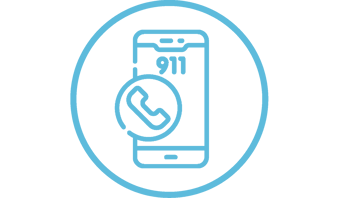RAY BAUM’s Act – Are You Ready?
You’ve probably never heard of Ray Baum, but he’s the namesake of new regulations that aim to help people receive the assistance they need when they call 911.
RAY BAUM’s Act mandates that emergency responders are provided all the vital information required to determine the “dispatchable location” and quickly reach a 9-1-1 caller regardless of the device they dial from or their exact location inside a large building.
The critical component of this law is that it applies to any device that can conduct a phone call or dial a number, regardless of the technological platform it utilizes. No matter the device (wired, wireless, remote, or on-premise), if it connects to an MLTS (multi-line telephone systems), it will now fall under the FCC’s jurisdiction. With the passing of this law, it is time to get your business entirely complaint in order to help protect lives and prepare for an emergency should one occur.

Similar to Kari’s Law, the United States Federal Communications Commission (FCC) has been dedicated to enforcing RAY BAUM’s Act with consequences for businesses that do not comply with these vital E911 regulations. These penalties come in addition to the risk of exposure to litigation, and significant judgments served as a call to action for organizations.
The good news is that complying with these regulations is not a daunting task, and with the help of modern technology and guidance from your service provider, it can be done relatively quickly. Below, we dive into everything you need to know about RAY BAUM’s Act and your responsibilities.
What is RAY BAUM’s Act?
RAY BAUMS is an acronym, and it stands for Repack Airwaves Yielding Better Access for Users of Modern Services. The name of this act shows it is inspired by the late Ray Baum, a lawyer and congressional representative who advocated for this telecommunications legislature. The complete act comprises a broad set of consumer protections that the FCC will regulate. However, Section 506 relates specifically to E911 compliance and creates new rules for multi-line telephone (MLTS) systems and how they operate in an emergency situation.
Each year, over 240 million emergency calls are conducted in the United States alone, and in some areas, 80% of these calls are made from a wireless device. Telecommunications technology has modernized rapidly and now includes mobile devices, VoIP, laptop softphones, and more, all of which can make it much more difficult for emergency personnel to locate a caller’s exact location when compared to the traditional “hard” phone or desk phone. Due to the wide variety of sources from which calls can be made, first responders sacrifice critical response time trying to locate individuals. This time lost can lead to tragedies that could have been prevented.
Why is RAY BAUM Important?
Modern enterprises and large campus environments are composed of massive, multi-level buildings with complex layouts. A first responder called to one of these buildings, which only has the physical street address, will be unlikely to locate the distressed individual in a 5th-floor office or conference room on the first try.
RAY BAUM’s Act requires all types of businesses that use and operate phone systems to provide dispatchable, accurate location information to onsite staff and the public-safety answering point (PSAP)-or their local emergency dispatch center responding to emergency calls. Dispatchable location information provided to the PSAP must include a valid street address, plus other locating information such as building, floor, suite, or room number “necessary to adequately identify the location of the calling party.” These requirements for dispatchable locations are for any device your business operates (on-premise, remote, etc.).
When Does RAY BAUM’s Act Go Into Effect?
The first section of RAY BAUM’s Act Section 506, covering traditional or wired devices, has already been effective since January 6, 2021. In contrast, wireless and mobile offsite device coverage went into effect at the beginning of the year , on January 6, 2022.
With effective dates almost entirely in the past, it is a good idea to implement a future-proof solution for your business that protects your remote works and minimizes your risk of liability. Make sure you are fully covered by choosing a phone system with an E911 solution that also meets the requirements of Kari’s Law, which has been in effect since February 16, 2020.
How to Comply with RAY BAUM?
RAY BAUM’s Act requires specific guidelines for various device and location types, which your phone system’s E911 solution must cover. Here is a quick overview of the essential requirements of the act.
Dispatchable Location
Section 506 of RAY BAUM’s Act and the FCC define a dispatchable location as “the street address of the calling party, and additional information such as room number, floor number, or similar information necessary to identify the location of the calling party adequately.”
Fixed MLTS Calls
As of January 6, 2021, fixed MLTS devices, on-premises must automatically provide a dispatchable location.
Non-Fixed MLTS Calls
As of January 6, 2022, MLTS service providers must automatically convey the dispatchable location on all devices operated by a business.
Off-Premises 911 Calls
As of January 6, 2022, for off-premise 911 calls, the MLTS operator must provide an automatic dispatchable location, a manually-updated dispatchable location, or enhanced location information derived from coordinates and consisting of the best available location information or a combination of technologies in order to provide an accurate location should an emergency occur.
Does RAY BAUM Apply to My Company?
If your business owns, operates, rents, leases, or utilizes a on-premise, hybrid, or hosted Multi-Line Telephone System (MLTS), RAY BAUM’s Act will apply to your business.
Suppose you are primarily responsible for managing your telecommunications systems. In that case, it is your responsibility to comply with the act and employ a phone system with an E911 solution that covers all devices that can carry out phone calls (i.e., hard and softphones). If a device on the phone system can complete a call to 911, the system must automatically be able to send location information to the PSAP should an emergency call occur.
Your chosen solution must be able to deliver the necessary dispatchable information to the PSAP so that emergency personnel can reach the distressed individual(s) as quickly as possible, even if the caller is unable to speak. This means that if your company operates out of a multi-level building, the device used to conduct the call must provide the PSAP with accurate and exact location information.
If you are unsure how this act applies to your organization or have questions about how your business can completely comply with these new regulations, contact us at Simplicity for E911 legislation and technology assistance!



